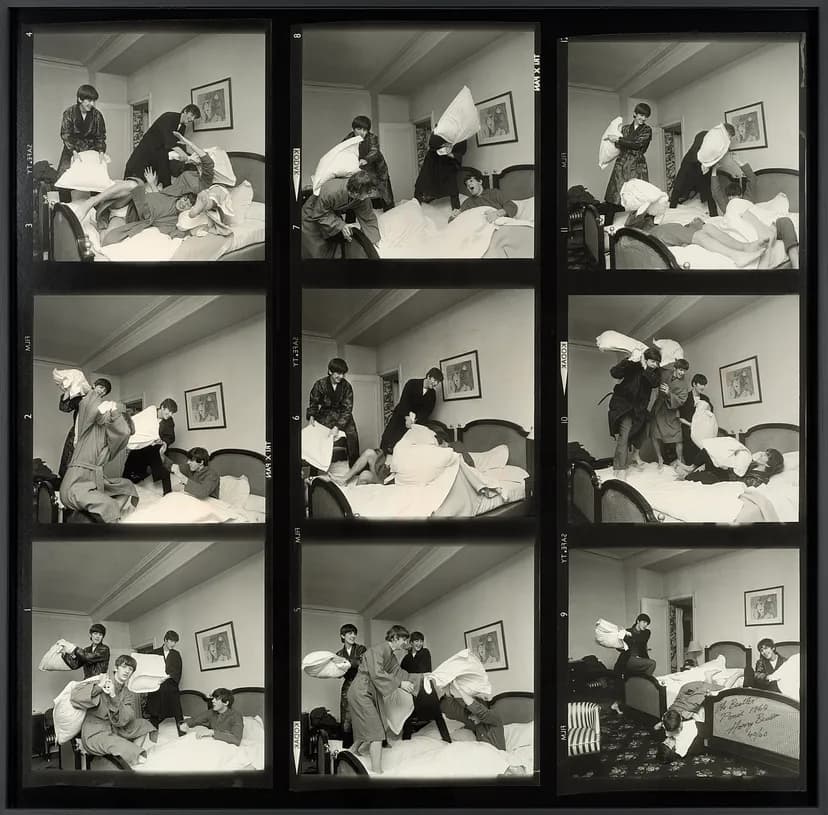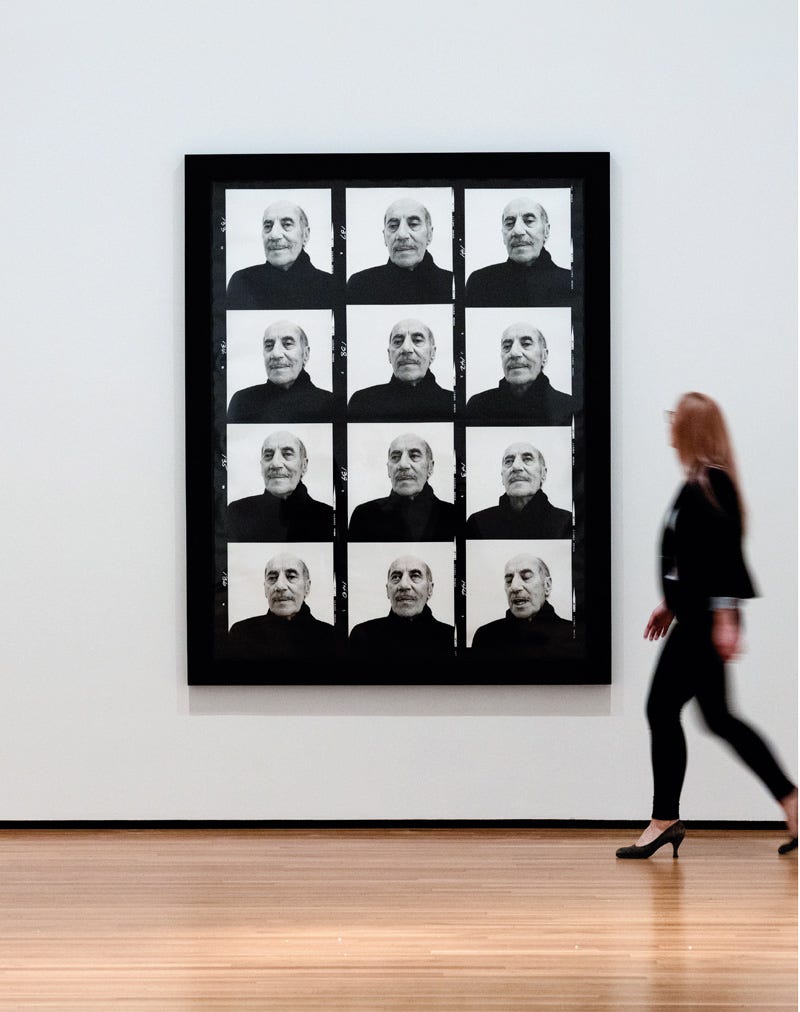Freeze-Frames: Pop Culture & Celebrity
- Blog Post
- Exhibitions

The Beatles Times Nine, Contact Sheet, 1964, printed 2004. Harry Benson (American, b. Scotland, 1929). Gelatin silver print; 120.7 x 122.6 cm. © Harry Benson. Image courtesy of the Cleveland Museum of Art
Many images stop you in your tracks as you walk through PROOF: Photography in the Era of the Contact Sheet. You see wonderful Man Ray abstractions from 1926, Robert Frank’s look at everyday Americans in 1955, and O. Winston Link’s rumbling trains.
But even more fascinating are the celebrities stopped for us, held at one place and time on the arc of their legendary careers. Some of these images capture a global talent at the beginning. Some frame a celebrity in summation. But each photograph is one day in the life of a real human being, and the Truman Capote in the 1977 photo session is not the same Capote of the 1946 photos on view.

One of the most arresting contact sheets is Cecil Beaton’s session Audrey Hepburn in 1954. Hepburn continues to influence style decades after her death, and elements of her look are there in 1954: the pixie haircut, the simple black clothing. But she is not yet the full Audrey. She is just 24. This is the year after her triumph opposite Gregory Peck in the reverse-Cinderella romantic comedy Roman Holiday (opens in a new tab), for which Hepburn won the Best Actress Oscar. It is now the year of her Cinderella story Sabrina (opens in a new tab), in which she sings to Humphrey Bogart (and for which she gets another Oscar nomination). Most people alive today have seen her in only Breakfast at Tiffany’s (opens in a new tab) — or in posters of Breakfast at Tiffany’s — but that movie is seven years away from this photo session. In Capote’s novella, Holly Golightly is 19 years old; Hepburn is in her early thirties when filming the movie version. That age discrepancy is one of many strange things about the movie. If you really want to see Hepburn as Holly, this contact sheet is a much closer match.
The contact sheet The Beatles Times Nine by Harry Benson is not just another among thousands of publicity photos taken of the Fab Four. It is a very specific moment that helps set their image in the pop culture of the mid-20th century.

The four in these photos haven’t been to America yet. They are playing a residency in Paris in January 1964 just as their first U.S. album is released. Benson took these photos in their hotel after one of the many Olympia Theatre performances. In these photos, we see the nervous energy of performers tuning up to go to make-or-break America. A few days after these photos, the mischievous four will play on The Ed Sullivan Show on American TV, and their album Meet the Beatles will hit the top of the U.S. music charts and remain number one for 11 straight weeks. And the world will change forever.
In nostalgia for a simpler and more glamorous time, we swoon at these images from a postwar America and Europe at the peak of their influence. Does everyone look classier in black and white? Many of these celebrity images in PROOF were taken for magazines or other publicity when still photography was king. It was a time when most families had TVs that produced fuzzy images, and there was wide variety in the quality of movie prints and projection technology in theaters. For a high-definition image that could make a person into an icon, you used still photography.

Thus, David Bailey’s series of actor Michael Caine projects forward. Caine is on the verge of conquering the world. It’s amazing to see this young version of an actor now most recognized in America as the butler Alfred from some Batman movies. Caine today has two Oscars and 170 screen credits — including the 1978 killer bee horror film The Swarm (opens in a new tab). These photos take us back before that silliness to a swinging 1965 London. Caine’s breakthrough will come a year later with Alfie (opens in a new tab), a nearly one man performance with audacious talking right to the audience, for which Caine will get his first of six Oscar nominations. Alfie is a terrible human being but a fascinating character, and Caine seems to be already playing Alfie in these photos, performing savvy but self-absorbed sophistication. To help sell Caine to America, producers got Cher to sing the Alfie theme song (opens in a new tab) over the closing credits.
In 2020, it is hard to remember that early Cher — and then you are mesmerized by the contact sheet of her 1966 session with Richard Avedon.

In it, she has just turned 20 years old. It’s a year after her smash duet with Sonny Bono, “I Got You Babe,” which sells more than a million records.
This is the year Cher releases her second solo album and sells a million records with its single “Bang Bang (My Baby Shot Me Down (opens in a new tab)).” (Remember: she is TWENTY!) Today a young generation knows Cher from the Mama Mia (opens in a new tab) sequel, and their parents remember her Oscar-winning performance in Moonstruck (opens in a new tab) or her variety shows on 1970s TV. But in these photos, she is Taylor Swift and Lady Gaga and Ariana Grande. She is a 1960s emblem on her way to becoming a 1970s disco emblem. That bare back will be made iconic by designer Bob Mackie’s outfits — but Avedon captured it first.
As prominent as Cher’s back is Miles Davis’ hand in 12 Hands of Miles Davis and His Trumpet by Irving Penn.

The images come from 1986, when the legendary jazz creator had returned to public performance after a dark, reclusive period in the late 1970s. Don Cheadle’s 2015 movie Miles Ahea (opens in a new tab)d is an improvisational look at that dark time, with flashbacks to Miles’ early musical brilliance (Kind of Blue (opens in a new tab) remains the best-selling jazz album in history). Cheadle’s movie is one way to understand why in the late 1980s Miles performed concerts with his back to the audience. Another way is Penn’s contact sheet showing the tools of the music but not the face of the complicated man who used those tools.
But in most of these celebrity photos, the face is the story. At the dawning of a new media age, Penn photographed Ed Wynn as one of 21 comedians to be featured in Vogue, and Wynn wears the tired smile of a well-traveled clown. That’s who he was in 1951: the 64-year-old Wynn’s tiny hat and floppy necktie recall his beginnings in vaudeville stage shows in 1903. Even as a radio star in the 1930s, he wore bright costumes to goose laughs from live studio audiences. These photos could have been a memorial for a funnyman of a bygone era — except that Penn takes these photos the year Wynn voices the Mad Hatter in Disney’s Alice in Wonderland (opens in a new tab), and that performance sparks a career boom. Goofy old Wynn will get his own TV variety show, will star in the second Twilight Zone (opens in a new tab) episode ever aired, and will love to laugh on the ceiling in Mary Poppins (opens in a new tab) in 1964. Maybe if Wynn knew what was coming, he would have smiled more for Penn.

Avedon’s photos of Groucho Marx in April 1972 are clearly valedictory — part of a series of portraits he took of a generation of film artists about to pass, including directors Fritz Lang (1890–1976) and John Ford (1894–1973) and performer Charlie Chaplin (1889–1977). Marx and his brothers reigned in the 1930s with comedy classics such as Duck Soup (opens in a new tab) and A Night at the Opera (opens in a new tab), and in the 1950s he perfected the persona of the amused TV host on the gameshow You Bet Your Life (opens in a new tab). Avedon’s photos capture Marx in the year of his last film role, a cameo in Robert Redford’s satire The Candidate (opens in a new tab), and the year of his stand-up show at Carnegie Hall, released as the album An Evening with Groucho (opens in a new tab). After this, his last major public appearance is to get a lifetime achievement Oscar in 1974. In his eyes you can see all the jokes and all the slapstick scenes he has already given the world.
Standing with the oversized Avedon portrait of him in PROOF feels like sharing a living memorial with the actor himself. And we are happy to spend one more moment in time with Groucho.